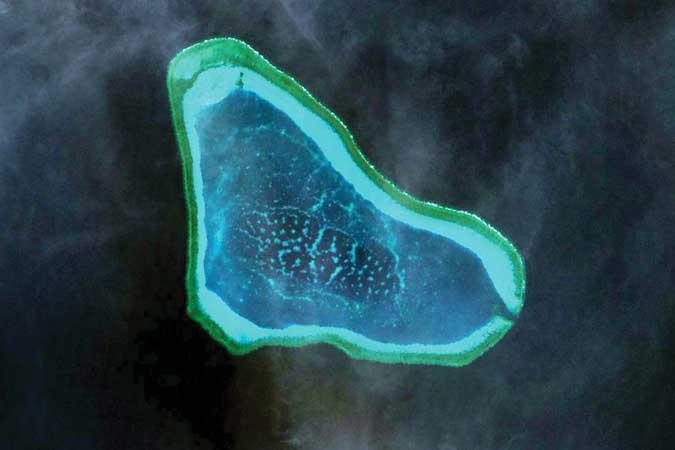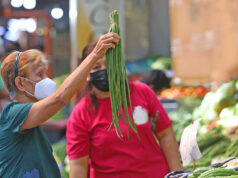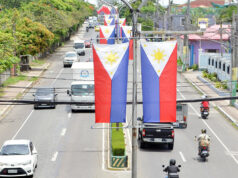Philippine security council wants fishery report on cyanide use in S. China Sea

By Kyle Aristophere T. Atienza, Reporter
THE PHILIPPINES is keen on coming up soon with its complete report on the alleged use of cyanide by Chinese fishermen encroaching Scarborough Shoal, locally known as Bajo de Masinloc.
On Monday, National Security Council (NSC) Spokesman Jonathan Malaya told a news briefing that the Bureau of Fisheries and Aquatic Resources (BFAR) has been ordered to finish its post-mission reports and submit all the evidence it has gathered to the country’s West Philippine Sea task force.
“We at the National Security Council are alarmed by this development that is happening, but we have to be careful also, so we have to validate and investigate [the use of cyanide by Chinese fishermen].”
In a forum last week, BFAR spokesman Nazario Briguera said Chinese fishermen have been using the deadly chemical compound in the area, 124 nautical miles off the Philippines’ main northern island of Luzon.
He said the practice of foreign fishermen have caused damage potentially exceeding P1 billion. “They intentionally destroy Bajo de Masinloc to prevent Filipino fishing boats from fishing in the area,” Mr. Briguera said.
In a statement, the Chinese Embassy in Manila belied the allegations of use of cyanide by its fishermen.
“The allegation against Chinese fisherman is totally baseless and sheer fabrication. China has indisputable sovereignty over Huangyan Dao and its adjacent waters,” it said of Scarborough Shoal.
“The Chinese Government attaches great importance to the protection of ecological environment and conservation of fishery resources, and have taken resolute measures to crack down on any illegal fishing activities,” it added.
The Philippine Coast Guard (PCG) had said that President Ferdinand R. Marcos, Jr. had instructed stricter patrols in the area.
Scarborough Shoal has been a major source of tensions between the countries, with the Chinese Coast Guard preventing Filipino fishermen from accessing the fishing ground, which falls within Manila’s 200-nautical mile exclusive economic zone.
In mid-January, a China Coast Guard ship deployed a rubber boat to chase a small boat of Filipino fishermen collecting shells in the vicinity of the shoal.
One of the five Chinese personnel forced them to return the shells to the sea before being allowed to leave. They were subsequently driven away.
A 2016 arbitral ruling that invalidated China’s expansive claims in the South China Sea recognized the traditional fishing rights of small-scale Filipino and Chinese fishermen in the shoal.
Mr. Malaya said once the report is validated, it would be sent to the Department of Justice and the Office of the Solicitor General, which are working on a case against China for environmental degradation.
“The challenge here is to prove the responsibility for the coral degradation and the impact to the environment is coming from these specific people,” he said at the Monday briefing.
“We need to connect them. We have to have solid evidence to prove so that once we file the case, we won’t have a hard time proving it to the court,” he said in mixed English and Filipino.
“When we go to court, we have to have solid evidence to back your claim.”
ESTABLISH SEA LANES — LOCSIN
In Congress, Philippine Ambassador to the United Kingdom Teodoro L. Locsin, Jr. called on the government to push for measures that would establish archipelagic sea lanes to safeguard the country’s marine resources.
“Our archipelagic sea lanes must include normal passage routes or international navigation and overflight and of course innocent passage,” Mr. Locsin told a Senate Maritime and Admiralty Zones committee hearing.
“They [sea lanes] should be required to show sufficient capability to put in place mechanisms that enhance maritime safety and give convincing proof that our proposals will enhance the positive impact of orderly vessel traffic,” he said.
Under the United Nations Convention on the Law of the Sea (UNCLOS), an archipelagic state such as the Philippines may designate these sea lanes to ensure the “continuous and expeditious passage” of foreign vessels and aircraft in or over its archipelagic waters.
Mr. Locsin said that the International Maritime Organization would be in-charge of adopting Philippine proposals for archipelagic sea lanes, which he said would take time to process.
“We are [one of] the only two serious archipelagos on the planet,” Mr. Locsin said. “As sprawling archipelagos, we are most vulnerable in this particular aspect; our major islands are the sizes of many countries; the waterways between them offer wide approaches.”
Senator Francis N. Tolentino, who heads the committee, formed technical working groups composed of officials from the Departments of Foreign Affairs (DFA), of Justice (DoJ), the NSC, the National Mapping and Resource Information Authority (NAMRIA), and the PCG.
He said the measure would likely be submitted to plenary by March.
Last year, NAMRIA said it would finish mapping Philippine territories in the South China Sea by 2028.
Mr. Tolentino has said the special committee on maritime and admiralty zones would craft a Philippine map to assert the country’s claim in the South China Sea in response to China’s so-called 10-dash line map.
The Philippines, Vietnam, India and Taiwan have criticized the map for covering regions beyond China’s borders and claiming most of the South China Sea. — with a report from John Victor D. Ordoñez



